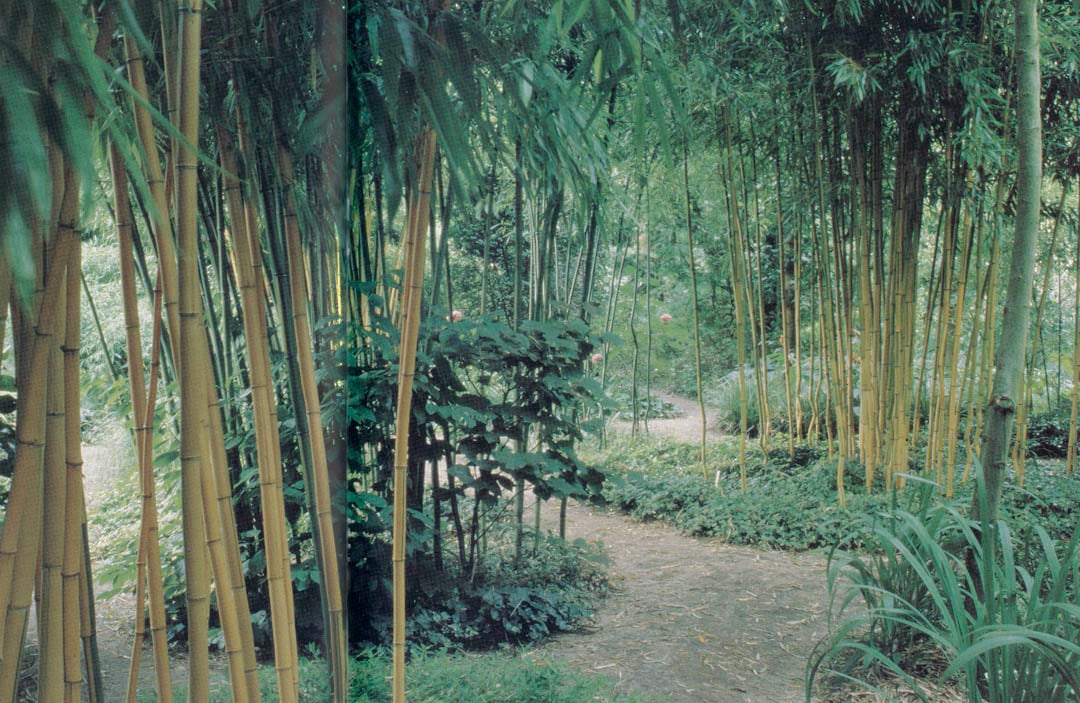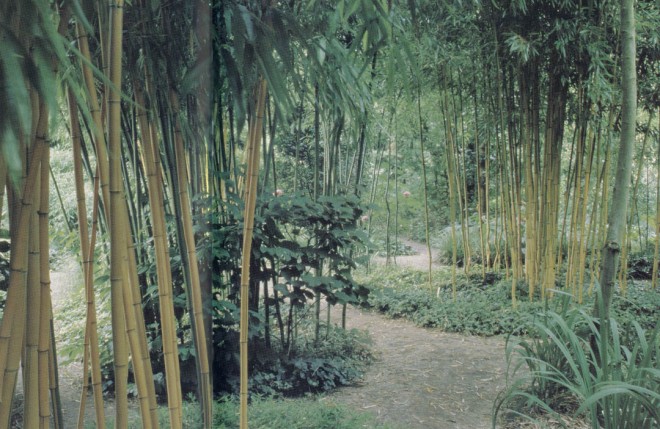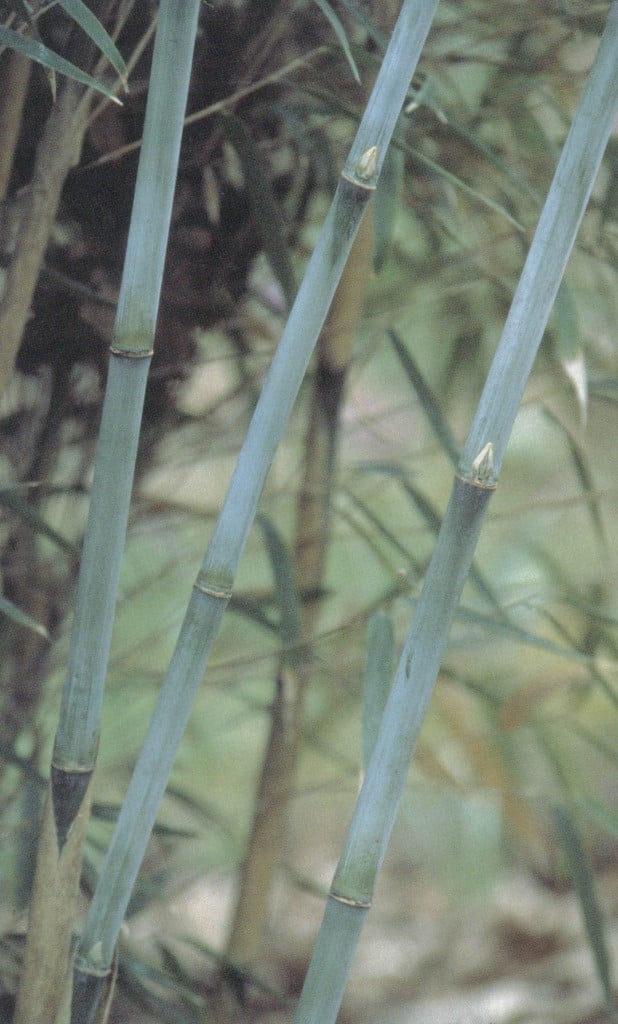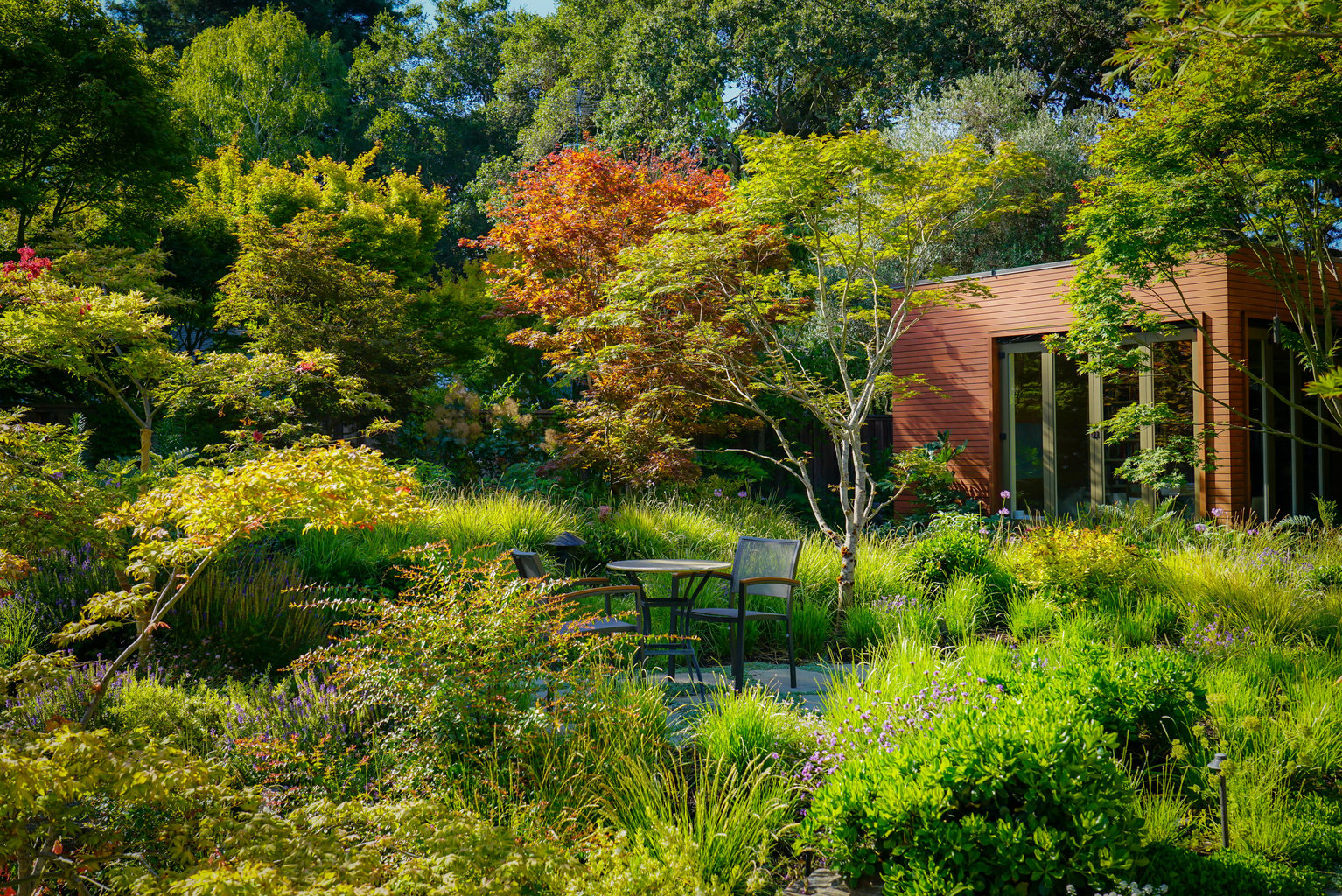

Contributor
- Topics: Archive, Plants You Need

Bamboo: the word engenders romantic and exotic images of tall canes (or culms) swaying in the slightest of breezes in distant tropic lands. Many species make handsome, serviceable, and well-behaved garden plants for Western gardens (see Pacific Horticulture, Spring ’95 and Spring ’97). Culms of most species are some tint or shade of green, but bamboos have much more to offer colorwise. Introductions by specialist nurseries and the American Bamboo Society over the last couple of decades have resulted in a myriad of colored canes. Touring a private bamboo collector’s garden can be an overwhelming experience with the diversity of sizes and foliage types and the kaleidoscope of colored culms. Plants are coming to us now from the Orient, Central and South America, and Africa.

Running With the Gold
Among the running timber bamboos (Phyllostachys) from China are several golden-culmed cultivars. If you look closely at the stem of one of these timber bamboos, you will notice a characteristic groove called a sulcus, or bud canal, that is caused by the presence of a branch bud when the pliable new culm was developing and rapidly lengthening. The sulcus may display the same green color as the rest of the culm, as seen in the common Japanese timber bamboo (P. bambusoides), or it may be golden (P. bambusoides ‘Allgold’). The sulcus might also be green on a golden culm (P. bambusoides ‘Castillon Inversa’), or a yellow sulcus can have an otherwise green culm (P. bambusoides ‘Castillon’). These color patterns are common in the various species of Phyllostachys. In fact, a considerable number of named cultivars are based on the color of the culm alone.
Golden Chinese timber bamboo (Phyllostachys vivax f. aureocaulis) is a relatively new introduction that grows prolifically and offers an exhilarating experience for the gardener; unfortunately, it cannot tolerate high winds due to the thin walls of the culms and is often too tall for small gardens. There are plenty of other bamboos with golden culms, and one is bound to be tailor-made to your specific requirements. Fishpole bamboo (P. aurea), for instance, is ideal for the West Coast; it is drought tolerant, erect, ideal for climates with low humidity, and generally reaches only fifteen to twenty feet tall. Its cultivar, golden fishpole bamboo (P. aurea ‘Holochrysa’) is a perfect solution for small gardens and offers further interest with its distorted swellings caused by the crowded internodes, particularly at the base. For a crooked culm, consider golden crookstem bamboo (P. aureosulcata f. aureocaulis). If large, blowsy foliage with subtly striped variegation is desired, the slightly taller P. bambusoides ‘Allgold’ would be a fine selection. The increasing array of bamboos with colored culms becomes a delight to ponder when seeking the ideal plant for ones particular circumstances.
Even more exciting are the cultivars now available with pin-striped culms. Phyllostachys aureosulcata ‘Harbin’ is the same as the species (green culm with egg-yolk yellow sulcus) but is marked with fine yellow stripes running the length of each internode. Its opposite is ‘Harbin Inversa’, which has a pure golden culm with fine green stripes. Pin-striping is not unique to just this one species but occurs also on P. bambusoides in the cultivar ‘Kawadana’, with subtly creamy white variegated foliage and fine striped culms.

Bamboos with golden culms require full sun to develop their dazzling color. When the developing culm is first exposed to light, it may develop a blush of cherry red, contrasting with the sulfurous yellow on the side of the culm unaffected by the sunlight. This blush of youth fades over the year, maturing to a deeper golden yellow. This does not happen in all of the cultivars, but when it does, the effect is captivating. Add to this a green sulcus, such as that on the ever-popular Phyllostachys bambusoides ‘Castillon’ or the justly named P. aureosulcata f. spectabilis. Combining such cultivars with the pure golden-culmed cultivars results in a ballet of dancing colors. This composition might be sobered up by adding a splash of green culm with yellow sulcus, as in P. bambusoides ‘Castillon Inversa’. Too much green foliage? Add a sprinkle of P. aurea f. albovariegata, whose leaves display prominent apricot orange stripes that mature to white and fade to two tones of green by the end of the summer. The secret to successful groupings is combining cultivars (preferably from the same species) that exhibit equal vigor and habit.
For a stronger contrast, combine Phyllostachys sulphurea f. viridis, with its matte sulphurous yellow culm, or P. vivax f. aureocaulis with black bamboo (P. nigra). In different climates, the culms will develop varying degrees of color. In northern Oregon and Washington, P. sulphurea f. viridis remains a subdued yellow, while in southern Oregon and all of California, it truly is sulphurous yellow.
Are all yellow culms alike? That would be far too unimaginative. Phyllostachys vivax aureocaulis, for instance, is the palest of yellows, whereas P. bambusoides ‘Allgold’ mimics the last embers of light from the dying evening sun. A golden culm can also develop green random pin stripes, or thicker lines known as panels. Occasionally, the whole side of a culm will be green, as often happens on P. vivax f. aureocaulis and P. sulphurea f. viridis. This instability is wondrous for the variety it brings to a composition; fortunately, these cultivars will usually not revert to pure green culms.
There are numerous subtly colored bamboos that display a modest blush of burgundy on an otherwise glossy green culm. This can be seen on the narrowly erect, running Semiarundinaria fastuosa or the profoundly cold hardy Phylostachys aureosulcata and P. nuda.


The Darker Colors
The most popular timber bamboo of all is black bamboo (Phyllostachys nigra). Black bamboo was given the species name, nigra, meaning black, because that was the form first collected. (A green-culmed selection has been given the name P. nigra ‘Henon’.) The culms of black bamboo are initially green, developing a dark brown stippling around each joint (or node) that eventually fills in with increasing intensity over the surface of the culm. Mature culms are almost black. The intensity of sunlight is key: in shady locations or in unthinned stands, the blackening process takes longer. The collage of green and various stages of black is one of the most appealing aspects of black bamboo. This species has a couple of other tricks up its sleeve: ‘Megurochiku’ produces a green culm with chocolate-colored stripes, whereas ‘Boryana’ develops brown, cloud-like markings that are enhanced when the culm is not in direct sunlight. Other bamboos with brown, cloud-like markings are P. glauca f. yunzhu and Sasa palmata f. nebulosa.
I have left my favorite of the darker-culmed bamboos until the last: Phyllostachys violascens. This unsung beauty has purple black new shoots that fade to green as summer advances. If you look carefully at the green culm, you will observe subtle yellow stripes on the internode which gradually evolve through mustard yellow to violet. Imagine the joy of planting this violet-stemmed species with the closely related, but later sprouting, P. iridescens. This last bamboo develops mustard yellow stripes on dark, vibrant green culms that blush red when first exposed to the sun. With a thicker culm wall, it will also add strength to the thin-walled P. violascens.
Mostly cultivated for their habit and variegated foliage, a few shrubby bamboos offer colored culms. Semiarundinaria yashadake ‘Kimmei’ and Pleioblastus chino ‘Kimmei’ are the best examples; kimmei is Japanese for “golden with green stripe.”

Colorful Clumpers
For the gardener with limited space, a number of clump-forming bamboos offer beautifully colored culms. Among the most note-worthy of the hardy species is candy cane bamboo (Himalayacalamus falconeri ‘Damarapa’). Most species in this group require dappled light in the afternoon. Some have green culms with a blush of red around the joint, as seen in the tightly clumping Himalayacalamus asper and in most species within the genus Drepanostachyum. The recently introduced Fargesia sp. ‘Jiuzhaigou’ is the most exciting of all, having new shoots that are green blue, turning bronze red in the following spring and eventually maturing to mustard yellow. Imagine this mosaic of color in a thicket of culms adorned with the most diminutive foliage—it is breathtaking!
Blue-culmed bamboos will always attract attention. Particularly notable are Fargesia nitida, Himalayacalamus hookerianus, and the rare Borinda boliana or B. fungosa. Sun-tolerant Thamnocalamus tessellatus from South Africa also has a blush of blue that matures to a dull green.

Chusquea cumingii maintains its blue wiry clambering culms; C. culeou is increasingly available, grown from seeds and displaying varying characteristics, the most notable selection being ‘Caña Prieta’ with a chocolate brown culm fading to green in the second year. The closely related C. culeou ‘Tenuis’ (syn. C. culeou ‘Breviglumis’) is a giant of a clumper at thirty feet tall and has such widely spaced culms that it appears to be a runner. The new culms of chusqueas are ever changing and variable in color according to the degree of exposure to sunlight. Striations of white, green, and red on the developing shoot and culm sheath are common, whereas the more mature culm rapidly turns a bright burgundy. After long term exposure to sunlight, the culm matures to an outstanding bright yellow.
A small group of tropical clump-forming bamboos have proven themselves cold-hardy to 15º F. Among the cultivars of Bambusa multiplex are a few delightful ones that work well in courtyard environments and small gardens. ‘Alphonse-Karii’ (usually labeled as ‘Alphonse Karr’) is the most exuberant of the group, having golden culms with random green striping. The rare Bambusa eutuldoides ‘Viridivittata’ (syn. B. Bambusa textilis ‘Vittata’) has colors similar to those of ‘Alphonse-Karii’, but the leaves are tiny, and it is tightly clumping with a graceful arching habit. Golden Buddha belly bamboo (B. tuldoides ‘Ventricosa Kimmei’) has striking golden culms with green stripes and distorted swollen internodes, especially when cultivated in containers.
With such magnificent culms who cares if bamboos do not produce colorful flowers. If, however, you really need some flowers within a planting of bamboos, consider planting a climber to twine up the culms. Climbing bleeding heart (Dicentra scandens), striking black-leafed sweet potato (Ipomoea batatas ‘Blackie’), the eastern native vine Menispermum canadense, and several nasturtium relatives (Tropaeolum azureum, T. peregrinum, and T. tuberosum) are neither strong enough to damage the bamboo nor persistent, making them fine complements to these colorful bamboos.
[sidebar]
A Bamboo Resource Guide
Bamboo nomenclature is continually being refined. For the most up-to-date information, and to learnmore about this fascinating and exotic woody grass, visit the American Bamboo Society website at www.americanbamboo.org. Available there are charts comparing the characteristics of the bamboos discussed in this article—and many more—as well as a complete list of sources.
[/sidebar]
Share:
Social Media
Garden Futurist Podcast
Most Popular
Videos
Topics
Related Posts

Low Maintenance Gardens – Better for Pollinators and People
Autumn 2022 “I come out every day. It’s therapy, my meditation.” Janet’s young garden transformed from overgrown, invasive plants to mostly natives. The dailiness of

Invasive Plants Are Still Being Sold: Preventing Noxious Weeds in Your Landscape
Autumn 2022 With so many beautiful ornamental plant species and cultivars throughout California and the Pacific Northwest, how do you decide which ones to include

Garden Design in Steppe with Transforming Landscapes with Garden Futurist Emmanuel Didier
Summer 2022 Listen to full Garden Futurist: Episode XVII podcast here. Emmanuel Didier, Principal and Creative Director at Didier Design Studio is a leading figure

Seslerias: Versatile Groundcover Meadow Grasses
Summer 2022 Without question, the most beautiful and versatile of all the groundcover meadow grasses are the moor grasses (Sesleria). Moor grasses tick off all









Responses